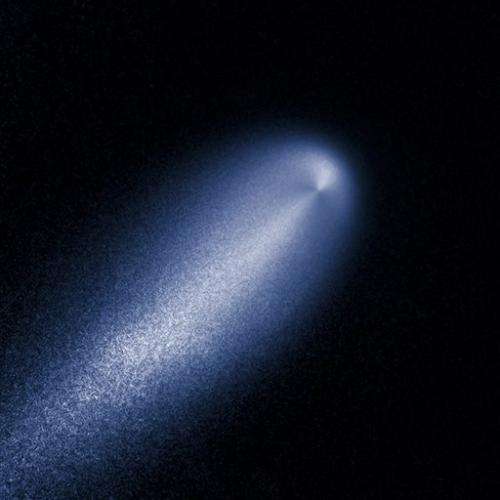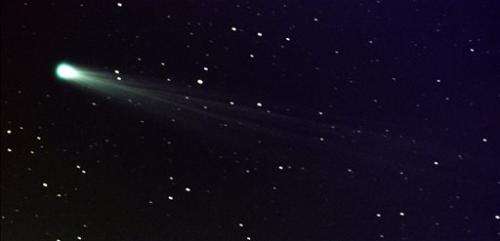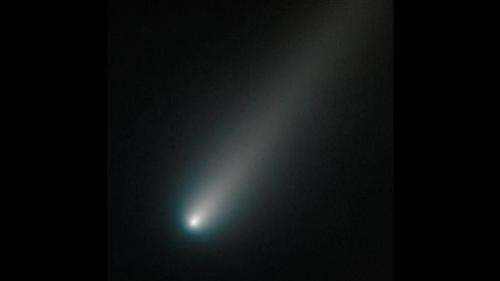In this photo provided by NASA, a contrast-enhanced image produced from the Hubble images of comet ISON taken April 23, 2013 reveals the subtle structure in the inner coma of the comet. In this computer-processed view, the Hubble image has been divided by a computer model coma that decreases in brightness proportionally to the distance from the nucleus, as expected for a comet that is producing dust uniformly over its surface. ISON's coma shows enhanced dust particle release on the sunward-facing side of the comet's nucleus, the small, solid body at the core of the comet. This information is invaluable for determining the comet's shape, evolution, and spin of the solid nucleus. (AP Photo/NASA)
Comet ISON is teasing the solar system as it dances with the sun and it's giving astronomers mixed signals.
Will it meet a fiery death—or survive—when it whips around the sun on Thursday?
The icy comet will be only about 1 million miles ( 1.6 million kilometers) away from the sun's super-hot surface during its close encounter on Thanksgiving. On Monday, it looked like it was about to die even before it got there. On Tuesday, it appeared healthy again.
"We have never seen a comet like this," Naval Research Laboratory astrophysicist Karl Battams said during a NASA news conference Tuesday. "It has been behaving strangely."
Because it is so close to the sun, ISON will likely not be visible from Earth on Thursday—except via a fleet of NASA telescopes and spacecraft aimed at the comet as it gets closest to the sun at 1:37 p.m. EST( (1837 GMT), he said. And it will be a few hours before scientists know whether the comet survives.
But even if the comet dies, Johns Hopkins University scientist Carey Lisse said there's a good chance that people on Earth will get an interesting cosmic show. The comet's remnants could paint the sky with a wide swath of green in the Northern Hemisphere.
In this photo provided by NASA, Comet ISON shows off its tail in this three-minute exposure taken on Nov. 19, 2013 at 6:10 a.m. EST, using a 14-inch telescope located at the Marshall Space Flight Center. The comet is just nine days away from its close encounter with the sun; hopefully it will survive to put on a nice show during the first week of December. At the time of this image, Comet ISON was some 44 million miles from the sun—and 80 million miles from Earth—moving at a speed of 136,700 miles per hour. (AP Photo/NASA, Aaron Kingery)
Lisse gives the comet a 30 percent chance of surviving, adding that it is just a gut-feeling that has little to do with logic. Logically, it should be 50-50, he said.
The comet—two-thirds of a mile (about 1 km) wide—is made up of loosely packed ice and dirt, essentially a dirty snowball. It is a "dinosaur bone," from the formation of the solar system 4.5 billion years ago, Lisse said. It has been in "deep freeze" for billions of years in the Oort cloud, a vast area of comets and debris that never formed into planets that's between 450 billion miles (724.17 billion kilometers) and 9 trillion miles (14.4 million kilometers) from the sun, he said.
The comet is racing around the sun, pulled close by our star's massive gravity, which can also break apart the dirty icy core.
Comet ISON was first spotted by a Russian telescope in September last year. While many comets come out of the Oort cloud and return after a long trip through the solar system and many comets graze by the sun, this is the first one that astronomers have watched that is from the Oort cloud and is skimming the sun.
Lisse said ISON could behave just like last year's comet Lovejoy, which fell apart a couple days after passing by the sun. Its remnants were visible like "a beautiful paintbrush swath in the sky" in the Southern Hemisphere, he said.
Unlike many blue comets, ISON has been more lime-green because it doesn't seem to have as much carbon monoxide as other comets, Lisse said.
In this photo provided by NASA, this Hubble Space Telescope image taken on Oct. 9, 2013 shows the comet ISON's solid nucleus. The new image of the sunward-plunging comet ISON suggests that the comet is intact despite some predictions that the fragile icy nucleus might disintegrate as the sun warms it. The comet will pass closest to the sun on Nov. 28, 2013. This color composite image was assembled using two filters. The comet's coma appears cyan, a greenish-blue color due to gas, while the tail is reddish due to dust streaming off the nucleus. The tail forms as dust particles are pushed away from the nucleus by the pressure of sunlight. The comet was inside Mars' orbit and 177 million miles from Earth when photographed. (AP Photo\NASA)
If the comet does make it around the sun intact and returns past Earth, the Northern Hemisphere should get good naked-eye views just before sunrise and just after sunset in the first couple weeks of December, Lisse said. But this probably won't be as bright and visible as 1997's Comet Hale-Bopp, said Geoff Chester of the U.S. Naval Observatory in Washington.
Over the last few weeks, the reports weren't good for ISON's survival. On Monday, astronomers at Kitt Peak Observatory "were a little bit worried and depressed" because the comet produced a classic sign of flaming out, Lisse said from the Arizona telescope. Earlier, astronomers thought it may have broken up.
Then on Tuesday, a solar telescope spotted the comet and it was growing brighter just as it should have.
"It's a wild ride, this comet," Lisse said. "The reports of ISON's demise have been greatly exaggerated for the last month or two and ISON continues to surprise us."
© 2013 The Associated Press. All rights reserved.


























